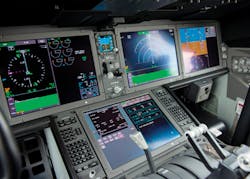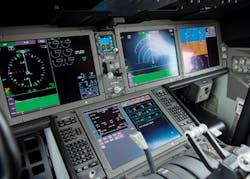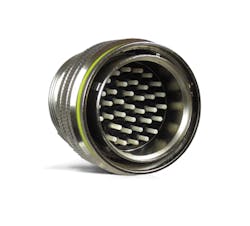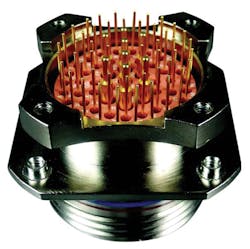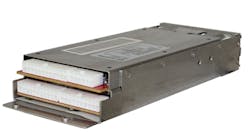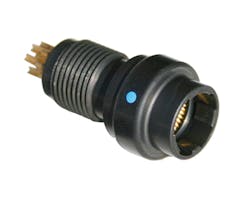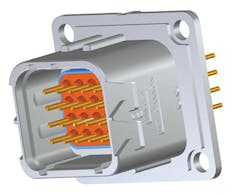Shielding against electromagnetic and RF interference for safety and mission success
Aerospace and defense engineers opt for innovative EMI and RFI shielding solutions and materials to protect safety- and mission-critical systems from intentional and unintended electronics emissions.
Aerospace and defense applications, platforms, and environments are undergoing a digital transformation, and the proliferation of portable electronics devices and embedded electronics systems is contributing to a significant increase in RF emissions that could cause interference, data corruption, or worse.
The number and complexity of electronics equipment and the threat of electronic countermeasures (ECM), ranging from radar jamming and deception to a devastating electromagnetic pulse (EMP) attack, are on the rise. All these factors are driving the need for greater protection from electromagnetic interference (EMI) and radio-frequency interference (RFI), both of which challenge aerospace and defense engineers today and could have disastrous effects on safety- and mission-critical systems.
Noise nuisance
All aerospace and defense equipment has to be able to operate in an electromagnetic spectrum, explains Chip Hutchinson, director of engineering at Crystal Group in Hiawatha, Iowa. "All electronics radiate in some way, shape, or form." EMI and RFI are more of an issue in this day and age, with so many personal electronics devices (PEDs) and embedded electronics systems throughout each vehicle - and all of it radiating.
"All those electronics radiate," Hutchinson says. "The problem is: If two pieces of gear were not designed to operate together, you have the potential for electromagnetic incompatibility issues, where the emissions of one device can cause a disruption in the operation or the failure of another piece of equipment." It's a serious concern, especially when lives or missions are on the line.
"When you talk about safety- and mission-critical systems, many have been designed some time ago, and now they are being put into an electromagnetic environment or spectrum for which they were not designed or where other radiators are now present," Hutchinson continues. "Those have the potential for causing disruption, loss of operation, or outright failure of those systems. When you are talking about the loss of a safety- or mission-critical system, that means somebody could die, a piece of equipment could be destroyed, or that the mission has failed."
"EMI protection is always a concern as 'more electrified' aircraft and vehicles bring potentially noisy components in the form of numerous and higher-voltage motors with attendant power supplies," says J. Grant Lawton, application engineer, military wire and cable, at W.L. Gore in the Philadelphia area. "At the same time, these components are being placed next to many high-speed data cables that have additional concerns for alien cross-talk.
"If system designers are concerned about noise resistance to adjacent data cables operating around 1.5 volts and with milliamp (mA) currents, then we can appreciate their concern when adjacent motor power cables could be operating over 270 volts and tens of amps," Lawton adds. "Specific to military applications, these concerns can be elevated by unique needs such as separating classified data from unrestricted data and meeting Tempest requirements. Highly effective EMI/RFI shielding is essential for assuring signal integrity and system integrity in today's data-intensive platforms."
EMI and RFI requirements
"We are in an environment where electronic warfare is a key component of the battle space. There are other adversaries who are specifically using electromagnetic emissions to interrupt or disrupt military equipment. In this case, EMI/RFI shielding is important to be able to ground those emissions - provide essentially a ground plane around the equipment where the equipment inside is protected from those harmful emissions," Hutchinson says.
"Almost all military applications require some form of EMI emissions control; that's why we have a military specification called MIL-STD-461," Hutchinson explains. U.S. Military Standard MIL-STD-461 describes how to test equipment to ensure electromagnetic compatibility. "It has been around for many, many years because [interference] has been a critical concern since really the advent of emissions.
"Aerospace and defense platforms are designed with compact, high-power units used very close together, sometimes developed by different manufacturers and integrated at the weapons platform level." As a result, Hutchinson says, "it is very important that everybody meets their own electromagnetic emissions and susceptibility requirements," such as those described in MIL-STD-461.
| ITT Cannon Double Flange Receptacles for PCB mounting |
"If I am making a piece of electronics, I have limitations on what it is allowed to emit" and how much it is susceptible to, Hutchinson describes. "If we both meet our specifications, the emissions I put out will not affect them because they have to be able to withstand at least that level of emissions to which I am limited." Problems arise when a device's emissions exceed the limitation and/or a device falls short of its susceptibility requirements. In short, one device emits more than another device can handle, resulting in the failure of the equipment.
"You have really four pieces in MIL-STD-461 that are critical: conducted emissions and conducted susceptibility, which is actually put on the physical power lines that connect the equipment together; and radiated emissions and radiated susceptibility, which is the stuff that is being put out in space," Hutchinson continues. "You have potential for constructive interference where two pieces of gear would join at a particular frequency to put out emissions. If I'm radiating at 200 MHz at a certain amplitude and someone else is radiating in the same area at 200 MHz and you had a piece of equipment that was susceptible at that frequency, you have the potential for a serious problem.
"Passing MIL-STD-461 does not guarantee you will not have an EMI compatibility problem. Likewise, failing MIL-STD-461 does not guarantee that you will have an interference issue," Hutchinson says. "If you are radiating and have an outage at a frequency no one is listening at, there's not a compatibly issue. If you are emitting within the limits of MIL-STD-461 at a frequency which another piece of gear, maybe a commercial off-the-shelf (COTS) piece of equipment, happens to have a susceptibility, you will have an interference problem, even if you are underneath the limit, if that other piece of gear wasn't designed and rated for this susceptibility in that environment. It's about spectrum management. Consider who is radiating at what amplitude and intensity at what frequency, and who is listening at those amplitudes and frequencies."
Design challenges
One of the big problems is the system designer's inability to eliminate all the noise, Hutchinson says. "Ulti-mately, from an RF perspective, we would prefer not to generate noise if at all possible. If you can't [avoid generating] it, you try to filter it and prevent it from getting to the outside world. That normally helps on the conducted side. On the radiated side, you should provide shielding.
"With the higher frequencies of electronics, antenna lengths are getting shorter - inverse with frequency," Hutchinson adds. "That means these very small components turn into antennas, and they start radiating and making noise that gets picked up. By nature of some designs, when you are dealing with electronics, you cannot eliminate all the noise from being generated."
A way of mitigating RF nose is using a switching power supply, in which switching controls voltage levels. "That switching transient [produces] noise at the frequency of the switching, so that translates to noise that gets out of the unit. Proper filtering and EMI shielding is what keeps that inside the box," Hutchinson says. "There's no way to get around it; by nature of making a switching power supply, it has to make that noise."
The generation of electronic emissions, or noise, can be unavoidable, but EMI and RFI issues can be avoided if protections, such as EMI/RFI shielding solutions, are put in place.
"You can do all the magic in the world to have a quiet box where it is properly shielded and all the emissions stay inside the box, but then you connect the cable. If you don't have it properly bonded and shielded at the cable interface, those emissions are now out into the same space just as if your box is creating it; they are leaking at the cables. So proper 360-degree coverage on the back cells, proper bonding of your cables is absolutely critical. Don't forget the cables and your peripherals," Hutchinson advises. In fact, he says, "watch for any place where two or more surfaces come together. Those are apertures; you need to watch the geometry of those things to make sure you don't emit."
Critical communications
"Mission-critical signals are increasingly in need of greater EMI and RFI protections in both military and commercial aviation applications," acknowledges Mike Savage, director of aerospace and defense product management at connector specialist ITT Cannon in Irvine, Calif. "As the rate and frequency of signals continue to increase, the likelihood of interference or crosstalk also increases, which could result in inaccurate data leading to incorrect mission intelligence and even possible loss of life.
"In military environments, any interference could potentially be leveraged by the enemy, resulting in dangerous scenarios affecting soldier safety. Another example on the commercial aviation side is the challenge posed by lightning strikes," Savage adds. One response he and his colleagues at ITT Cannon are seeing is an increased focus on utilizing composite materials and filters, when possible, to shield critical interconnects. "At ITT Cannon, our aviation customers have many high-power, high-bandwidth application requirements in interconnects and these increasingly complex demands are driving the latest advances in our technologies."
In commercial aerospace, the proliferation of in-flight entertainment and communications (IFEC) and wireless broadband connectivity in-flight potentially could cause interference with critical systems on the aircraft, Savage says. "Additionally fly-by-wire and the constant introduction of new electronics into the aircraft inevitably increase the complexity and density of the overall infrastructure, including cables, boxes, and connectors, which then requires more shielding."
At the same time, Savage explains, "damaged shielding can cause signals to short in cables, resulting in interference. For example, in avionics, interference from stray signals can cause misreadings and interference with ground-to-ground signals, telemetry, and global positioning systems (GPS). In military applications, EMI/RFI shielding is needed to protect mission-critical communications impacting soldier safety and situational awareness.
"Any interference can result in inaccurate radar signals, weapons systems deployment, and potential jamming by enemies. It is imperative that interconnects have optimal shielding to protect systems from outside signals that could damage or jam signals and make equipment inoperable," Savage stresses. ITT Cannon technologies support up to 10 gigabits per second in ruggedized packaging with 360-degree EMI shielding, he says. "In defense and military, customers require reliable and robust interconnects to ensure the safety and effectiveness of modern soldiers, military aircraft, as well as missile defense applications."
Composite conundrum
EMI/RFI shielding has become very important for several reasons, says Robert Moore, senior principal engineer at TE Connectivity in Redwood City, Calif. "Over the years, airframes have moved to more and more composite structures making up the whole aircraft. In the past, the aluminum airframe itself acted as a big shield to keep EMI out from outside the aircraft. Composite airframes themselves offer no shielding. Because of that, it becomes more important to provide shielding on the cables and overall harnesses to keep the EMI from coupling onto the wires.
"Shielding on the cables and harnesses has also become more important in the mitigation of lightning strikes as the shields are required to safely shunt the lightning energy where in the past, the metal airframe would serve that function," Moore continues. "Another reason that EMI shielding has become important is that the signals running on the aircraft have changed.
"ARINC 624/MIL-STD-1553 were the workhorse of data communications. Compared to other data standards used today, these are slow but robust," Moore says. "With the introduction of 100BaseT, gigabit Ethernet, 10 gigabit Ethernet, and IEEE 1394, the data rates are higher, the frequencies that make up the digital signal square waves are now in the gigahertz range so the cables themselves become a source of EMI. Since the data cables can be a source as well as susceptible, the shielding needs to keep signal in and protect from nearby cables. Even circuits that are used to change the position of a flap or aileron can be susceptible, and the use of Raychem FilterLine (AS85485) hook-up wire provides additional protection from EMI that couples onto the wire and would otherwise conduct along the wire by attenuating the EMI along the length of the wire."
Effective filtering
Filtering at the connector interface is often the most effective line of defense against the effects of EMI/RFI, admits ITT Senior Product Manager Dom Lecce. "However, the next level of signal integrity is in advanced shielding materials, and it is advisable to use multiple shielding options in certain applications."
ITT Cannon's D38999 filter connectors are employed in military applications like light control and radar systems for advanced unmanned aerial vehicles (UAVs), military aircraft, as well as weapon systems and improvised explosive device (IED) high-frequency detection systems. "Our high-density ARINC 600 TBKA filter-style interconnect is an established standard for navigation and control system protection for the worldwide commercial aircraft industry," Lecce says.
ITT Cannon engineers are using advanced Chip-on Flex technology, which enables them to package capacitors for filtering as well diodes and metal oxide varistors (MOVs) for transient voltage surge (TVS) associated with lightning - "all within the same connector, resulting in a very lightweight and high-performance, compact design," Lecce explains. Further, customers are opting for "ITT Cannon Filter MDM Microminiature designs in both C- and Pi-Filter configurations... for missile guidance systems where connector size is critical."
"Engineers and engineering managers should seek out partners who have a solid knowledge of high-frequency, voltage surge suppression, and filtering solutions, as well as experience designing, testing, and qualifying highly-engineered interconnect products," Lecce advises. "Today's modern shielding demands require a company that has a combined perspective of electronics and connectors." Indeed, more aerospace and defense engineers are opting to take a more holistic approach.
"Many factors affect the choice of the best EMI shielding materials for an application," a materials expert at W.L. Gore in Newark, Del., explains. "These factors include the materials used in the enclosure, the environment in which the product will be used, performance requirements for the shielding materials, quantity to be manufactured, and preferred installation equipment."
RFI shielding
"As electronics become more complex, they require more radio-frequency (RF) shielding. Fly-by-wire systems in aircraft, safety systems, and even passengers carrying tablets or phones, and there's more electronic interference around than there was just a few years ago," says Scott Gunderson, global aerospace and defense market manager at Parker Chomerics in Woburn, Mass. "All platforms and vehicles, components, and systems need EMI/RFI shielding. Aircraft, combat vehicles, ships, communications equipment, safety equipment, missile systems and launchers - everything needs shielding to operate functionally."
Parker Chomerics' shielding solutions help make military aircraft less susceptible to damage from lighting strikes, whereas its coatings and EMI shielding gaskets protect mission-critical missile systems from RF interference. "Obviously, you wouldn't want an enemy to be able to remotely launch your missile with an RF transmitter," Gunderson adds. "Chomerics also makes shielded coatings for low observable aircraft, allowing for radar to be absorbed - making the plane nearly invisible to radar."
"You never want to go cheap on EMI/RFI shielding. You always want to select the highest-quality shielding you can afford for an application - because of how much more RF radiation is in the air, even compared to a decade ago. It really does depend on your application, but choosing a premier supplier for EMI/RFI shielding helps combat and protect your mission-critical systems," Gunderson says. "Aerospace and defense vehicles and systems all need to be protected from the barrage of electronic transmissions today and well into the future."
"The design engineer should not settle for cables and components that they suspect are 'good enough,'" Gore's Lawton says. "Today's platforms are increasingly dependent upon electronic systems, which must communicate reliably and accurately. Cables are the lifeline of these systems."
Aging platform protection
Relatively old Qualified Products List (QPL) solutions are not meeting EMI protection requirements, explains Dennis Brondi, communications manager at Eaton Interconnect and Power Communications Manager in Camarillo, Calif. "For example, MIL-DTL-55181 QPL power connectors were designed over 30 years ago when there was a much lower density of electronics equipment, including radios, and less breadth of transmission frequencies and electronics component operating frequencies that need to be protected against when compared to today's military vehicles.
"The original MIL-DTL-55181 QPL design contributes to today's EMI-protection problems because it only provides incidental shell-to-shell grounding continuity," Brondi continues. "To reduce the electrical resistance through the shell-to-shell interface, Eaton is introducing MIL-DTL-55181 power connectors with patented conductive-insert arrangements (U.S. patent #9437979 B2, published 9/6/16). Incorporating conductive inserts, instead of adding grounding pins facilitates backward compatibility with the large installed base of MIL-DTL-55181 power connectors, albeit mating receptacles, plus both need conductive inserts to facilitate lower-resistance ground paths."
Mobile missile-defense systems and artillery are key applications, requiring connectors that facilitate accelerated set-up times, provide exceptional EMI protection, and withstand high levels of shock and vibration. To meet these requirements, Eaton's MIL-DTL-38999 Series IV connectors incorporate 360-degree grounding fingers that reduce shell-to-shell electrical resistance and improve electromagnetic and radio-frequency interference (EMI/RFI) protection, Brondi says.
"Connectors must have 360-degree electromagnetic compatibility (EMC) screening, and the distance between differential electrical pairs must comply to certain rules in order to prevent cross talk, information loss, or signal degradation," says Serge Buechli, marketing manager at LEMO Connectors in Ecublens, Switzerland.
Fiber optics for EMI and RFI immunity
"Fiber-optic interconnect solutions are ideally suited for high-speed, high-reliability, EMI/RFI-immune, digital data transmission in harsh environment applications, such as airborne avionics and computers, battlefield communications, and weapon systems," officials at Amphenol in Wallingford, Conn., say. "A large amount of data, voice, and video has to be securely transmitted in these applications, sometimes over long distances. Fiber-optic links, with large bandwidth and a small diameter, provide a fast, reliable, lightweight, and simple method to transmit a huge amount of information between various systems.
"Fiber-optic links only carry light pulses making them immune to electromagnetic or RF interferences, which are a threat to the integrity of the transmitted information. Fiber-optic links suit battlefield communication systems exceedingly well where secrecy and data integrity are paramount," Amphenol officials explain. "Light pulses from fiber-optic links can't be detected or hacked, making the link virtually invisible."
Some aerospace and defense applications have made strides using copper for high-speed connections, while others have migrated to fiber, depending on the environment, admits Mike Savage, director of product management, aerospace and defense, at ITT Cannon in Irvine, Calif. "In more and more applications, fiber is the preferred option, such as on certain ground-to-ground missiles and smart munitions, military aircraft such as cargo and transport planes driven by weight restrictions and anti-jam requirements, as well as in shipboard systems."
Distance, size, and weight are prime considerations. "Anywhere that requires high data rates over significant distance or with weight, security, or electromagnetic interference (EMI) concerns can benefit from, or may require, fiber," says Ben Reed, general manager at Amphenol Fiber Systems International in Allen, Texas.
Despite their immunity to EMI and RFI, fiber optics have not achieved widespread adoption in aerospace and defense applications to date. "When it comes to fiber optics, their inherent problem is that fiber-optic cables are susceptible to shock - from sonic booms, IED hits, and so on - where metal cables are more sturdy," says Scott Gunderson, global aerospace/defense market manager at Parker Chomerics in Woburn, Mass.
Savage disagrees, explaining that "many of the historical limitations of fiber, such as durability and field serviceability, have been addressed and the demand for faster, lighter, and more EMI/RFI-resilient solutions will continue to push manufacturers to make investments in fiber technology."
Regardless, aerospace and defense applications are switching from copper to fiber for high-speed transmission, space savings, and security, says Jeremy Ruff, director of business development at Amphenol Borisch Technologies and Amphenol Griffith Enterprises in Providence, R.I.
Company List
Amphenol
Wallingford, Conn.
www.amphenol.com
Booz Allen Hamilton
McLean, Va.
www.boozallen.com
Crystal Group
Hiawatha, Iowa
www.crystalrugged.com
Eaton
Camarillo, Calif.
www.eaton.com
ITT Cannon
Irvine, Calif.
www.ittcannon.com
Molex
Lisle, Ill.
www.molex.com
Parker Chomerics
Woburn, Mass.
www.chomerics.com
Pasternack
Irvine, Calif.
www.pasternack.com
Raytheon
Waltham, Mass.
www.raytheon.com
TE Connectivity
Berwyn, Pa.
www.te.com
Verus Research
Albuquerque, N.M.
www.verusresearch.net
W.L. Gore
Newark, Del.
www.gore.com
